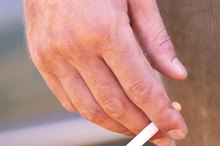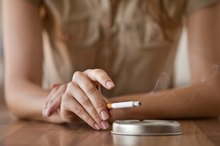What Happens After 15 Days of Not Smoking?
Most of us are aware of the harmful effects smoking has on the body. Inhaling tobacco smoke exposes the lungs — and ultimately all body tissues — to more than 7,000 chemicals — many of these harmful substances which can cause inflammation and damage in the body. But many are unaware of what happens to your body after you quit.
Even though most smokers understand the related health risks, quitting remains a difficult task, since the nicotine in tobacco is an addictive substance, and because the act of smoking can be a deeply ingrained habit that's difficult to break.
Anyone who smokes is advised to stop, as smoking is associated with serious long-term health problems, including cancer, lung disease, heart disease and stroke. But stopping smoking can also benefit your health immediately, with changes that occur within the first 15 days of going tobacco-free.
Read more: How Evan S. Used LIVESTRONG.COM's MyQuit to Kick His Smoking Habit & Lost 45 Pounds
The First 24 Hours
If you smoke, your lungs get exposed to a multitude of unhealthy substances including tar, nicotine and carbon monoxide, and these chemicals have direct effects on your blood pressure and pulse. Just 20 minutes after your last cigarette, blood pressure and heart rate start to return to healthy levels.
And within the first 24 hours, levels of carbon monoxide in your airways return to normal levels, and blood levels of carbon monoxide drop, allowing your blood oxygen to return to normal. Also, within the first day, blood circulation to the extremities begins to improve.
The Second Day
What Are the Timeline Benefits of Not Smoking?
Learn More
Within 48 hours of quitting, your sense of smell and taste can start to improve, and you may no longer have smoker's breath (everyone around you will be happy about that). Lung function will also start to improve. Soon after stopping smoking, the cilia, which are are broom-like hairs that clear toxins out of the lungs, start to work better.
After 48 hours of being tobacco-free, nicotine has left your body. While this is a healthful change, it may feel like a minor setback, as the reduction of nicotine in your body causes withdrawal symptoms, such as nausea or headaches. But keep pushing on; the continued benefits will be well worth it.
- Lung function will also start to improve.
- While this is a healthful change, it may feel like a minor setback, as the reduction of nicotine in your body causes withdrawal symptoms, such as nausea or headaches.
Within 15 Days
After about 15 days, the circulation of blood improves, enhancing removal of waste products and more effectively providing nutrients and oxygen to the body cells. Withdrawal symptoms should be less by this time, and the stains on your fingers and teeth may be improved. Your body, clothing and hair should no longer smell like smoke.
Also, lung function and your lungs' capacity to hold air improves. Although lung mucus production increases for the first few tobacco-free weeks, as the body works harder to clear the airways, by the start of the third week, there should be a drop in mucus production, fewer coughing fits and a reduced risk of respiratory infections. You might be breathing more easily and notice you're not as winded when you exercise.
- After about 15 days, the circulation of blood improves, enhancing removal of waste products and more effectively providing nutrients and oxygen to the body cells.
- Although lung mucus production increases for the first few tobacco-free weeks, as the body works harder to clear the airways, by the start of the third week, there should be a drop in mucus production, fewer coughing fits and a reduced risk of respiratory infections.
Beyond 15 Days
Steps the Lungs Go Through After Quitting Smoking
Learn More
The benefits of smoking cessation continue far beyond the first few weeks. By the third month, lung function can improve as much as 30 percent, according to a January 2011 article in JAMA Journal of Ethics.
Over the next several months, lung cilia function is restored, enhancing the ability of the respiratory system to clear out waste and toxins, and any shortness of breath symptoms may continue to improve.
By the end of the first year of being tobacco-free, the risk of heart disease is cut in half, and the risk of cancer and other tobacco-related chronic disease continues to drop. After 10 years of abstinence, the rate of lung cancer falls 50 to 60 percent, and 10 to 15 years after stopping smoking, the risk of heart attack and stroke declines to the incidence seen in non-smokers.
Read more: Top 10 Ways to Quit Smoking
- The benefits of smoking cessation continue far beyond the first few weeks.
- By the third month, lung function can improve as much as 30 percent, according to a January 2011 article in JAMA Journal of Ethics.
Ready to Quit Smoking?
If you're ready to stop smoking, work with your doctor to discuss a plan of action, which may include individual or group support, behavioral training or medications. Some people successfully quit on their own. But many people relapse after trying to quit.
Don't let this deter you, though, as relapse is a normal and expected part of the behavior change process. Take steps to figure out what you need in order to reduce the risk of relapse, and try again. Getting the support you need, particularly within the first few weeks of quitting, can help avoid a relapse. If you're ready to quit and are interested in medications or behavioral support from your health care team, contact your doctor.
Additionally, LIVESTRONG.COM's MyQuit app has helped thousands of people quit smoking. If you're looking for motivation to win your battle against nicotine, find inspiration in these LIVESTRONG.COM members' stories of how they successfully quit smoking using the MyQuit app. Reach out to the MyQuit community for ongoing support and motivation from people who know firsthand how difficult it is to quit.
Reviewed by Kay Peck, MPH RD
- If you're ready to stop smoking, work with your doctor to discuss a plan of action, which may include individual or group support, behavioral training or medications.
- Getting the support you need, particularly within the first few weeks of quitting, can help avoid a relapse.
Related Articles
References
- Centers for Disease Control and Prevention: A Report of the Surgeon General: How Tobacco Smoke Causes Disease
- American Cancer Society: Benefits of Quitting Smoking Over Time
- AMA Journal of Ethics: Health Effects of Smoking and the Benefits of Quitting
- Centers for Disease Control and Prevention: Smoking and Tobacco Use: Quitting Smoking
- National Cancer Institute: Harms of Cigarette Smoking and Health Benefits of Quitting
- Anesthesia and Analgesia: Helping Surgical Patients Quit Smoking: Why, When, and How
- American Family Physician: A ‘Stages of Change’ Approach to Helping Patients Change Behavior
- Centers for Disease Control and Prevention. CDC Fact Sheet: Quitting Smoking. Updated: May 21, 2015.
- Centers for Disease Control and Prevention. Health Effects of Cigarette Smoking. Updated: Oct. 1, 2015.
- Centers for Disease Control and Prevention. CDC Fact Sheet: Quitting Smoking. Updated: May 21, 2015.
Writer Bio
Marc Chase is a veteran investigative newspaper reporter and editor of 12 years. Specializing in computer-assisted reporting, he holds a Bachelor of Science in journalism from Southern Illinois University and a Master of Arts in public affairs reporting from the University of Illinois.








